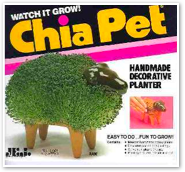
Originally published in The Blade on Sunday, December 17, 2006
By RYAN E. SMITH
BLADE STAFF WRITER
Have yourself a kitschy little Christmas.
Everyone else is.
This year, Santa’s sleigh is sure to be filled with Napoleon Dynamite dolls and Hello Kitty toasters. His reindeer will be weighted down with talking Family Guy pens and Johnny Depp bobbleheads.
Few can appreciate this like Matthew Donahue, a popular culture instructor at Bowling Green State University who has amassed a large collection of kitsch.
Mr. Donahue adores the stuff, talking lovingly about the tchotchkes — the “Mr. T” bank, the leg lamp nightlight inspired by A Christmas Story — in his Old West End house in a way only a true believer can.
But first things first. He takes a minute to direct a visitor to the Web site www.mcphee.com, a supplier for his collection, and points to the first category of kitsch that jumps out at him.
“This is kind of classic: the bacon/meat category,” he says. “You got your Gummi T-bone ...”
There’s also a bacon wallet, a corn-dog air freshener, and a sense that this guy really knows what he’s talking about.
“Kitsch, from a pop culture academic perspective, derives from a German word meaning ‘trash,’” he says. “To me, it’s kind of like camp pop culture items. ... It’s functional, but its the form that takes this kind of unique turn.”
So, it’s a toilet seat, but it is covered with images of dragons. Or it’s a pizza cutter that talks with the voice of Homer Simpson.
It’s definitely not high art or highbrow, but more people seem to be embracing it anyway.
“For me it’s something humorous,” Mr. Donahue says. “So bad it’s good.”
More importantly to businesses at this time of year, it sells.

Last year, for example, people bought more than a million Chia Pets, a holiday mainstay.
“They just come for the holidays, and then they go into hibernation the rest of the year,” says Michael Hirsch, executive vice president of San Francisco-based Joseph Enterprises, which makes the iconic decorative planters.
“Even my own mother-in-law [who lives in Holland, Ohio] says she doesn’t know it’s Christmas until she sees her first Chia Pet commercial,” he continues.
People buy them for a variety of reasons, but Mr. Hirsch admits that one is that they’re viewed as kind of funny.
“It’s been popular because it was a joke for a long time too,” he says. “We laugh along with people too.”
As they celebrate their 25th anniversary, Chia Pets might be considered old-school, classic kitsch. That would make Jay Kamhi the new kid on the block.
His company, Kamhi World in Clearwater, Fla., makes a number of talking products linked to TV shows or movies. He’s behind the Nacho Libre talking key chain and the Snakes on a Plane talking pen, each spouting out lines from their respective movies.
“I see more and more people getting into this type of stuff,” he says. “It’s becoming almost like a fashion statement to be kitsch.”
While past generations latched on to popular figures like Elvis Presley — don’t worry, he’s still around, as evidenced by the Graceland pop-up book that came out this fall — today’s consumers can indulge a quirkier fixation.
“With the advent of the Internet, you can actually tailor products to a very small segment of the population,” Mr. Kamhi says
His talking 40-Year-Old Virgin doll probably wouldn’t sell at your corner drug store, but he can make it because of the audience he can find on the Web.
For other products these days, there are large, built-in audiences. Like NASCAR fans.
One local company, Mark Feldstein & Associates, in Maumee, is hoping to cash in on the sport’s popularity with a NASCAR sounds clock.
It’s the same idea as the bird clock the company made in 1997. At the top of every hour, this clock plays revved-up sounds from a particular race car.
“A lot of people just like the sound of being by a racetrack,” said Howard Feldstein, marketing manager for the company. “It’s kind of a way to bring the racetrack to their home or office.”
These kinds of items may seem unusual and eccentric, but Mr. Donahue says that’s exactly the point. People embrace them as a way to show off their individuality.
In some ways, that’s incredibly important. It’s obvious to anyone who has seen a person like Mr. Donahue gush over their amazing collection.
“To me,” he says, “these are my family heirlooms.”
What would the holidays be without Chia Pets or NASCAR clocks?



MULTIMEDIA
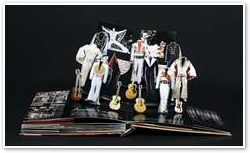
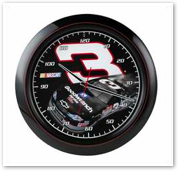
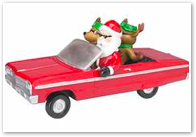
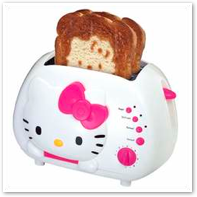
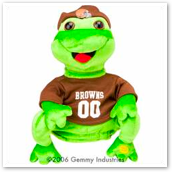
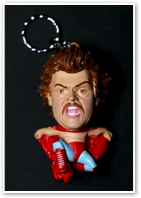
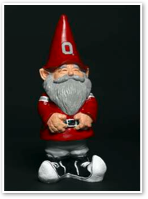

NASCAR Sound Clock (Mark Feldstein & Associates)
Forget about peaceful birds chirping every hour. This clock plays roaring sounds recorded from the race car driven by Dale Earnhardt.
Low Rider Santa (Gemmy Industries)
Santa and his reindeer bop to the beat of the song “Low Rider” as their car bounces up and down, showing off its hydraulics.
Hello Kitty Toaster (Sanrio)
Regular toast is so 2005. This appliance actually browns the famous face of Hello Kitty onto each piece of bread.
NFL Frogz (Gemmy Industries)
What does a frog singing and dancing to 50 Cent’s hit “In Da Club” have to do with football? Well, at least he’s wearing a Cleveland Browns cap.
Nacho Libre Talking Key Chain (Kamhi World)
It’s a key chain. It’s a caped, giant-headed version of Jack Black spouting lines from the movie Nacho Libre. It’s mucho kitsch.
Ohio State Garden Gnome (New Creative Enterprises)
The original maker of pink plastic flamingos went out of business this year, so garden gnomes may be all the kitsch our yards have left.
Chia Pet (Joseph Enterprises)
What time is it? Time to get the latest Chia Pet. Celebrating its 25th year, this classic holiday gift comes with a Chia Pet alarm clock.
